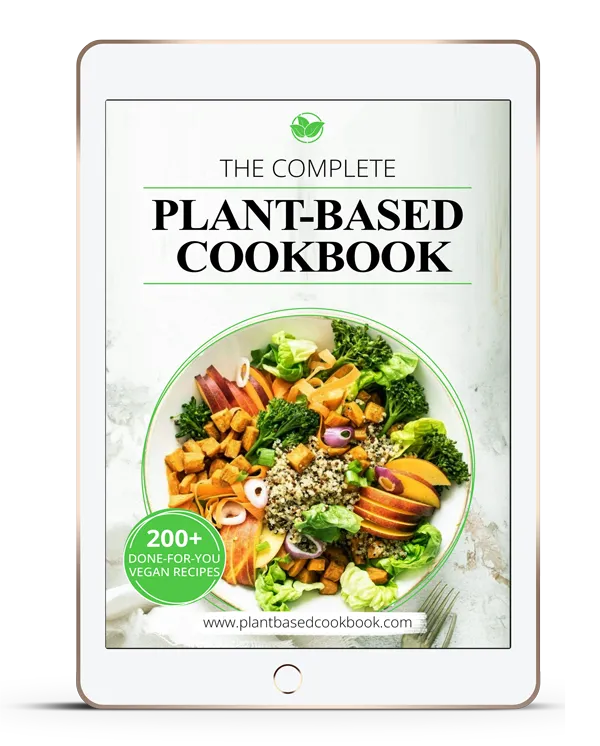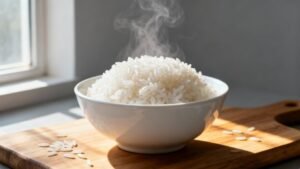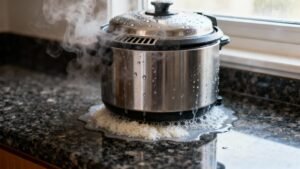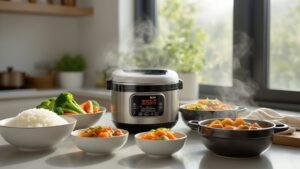How many times have we stared at a pot of rice that looks more like porridge than the fluffy grains we imagined? We’ve all been there—adding water by intuition, crossing our fingers, and hoping for the best. Well, actually, there’s a science to getting perfect rice every time, and it starts with understanding the precise ratios your rice cooker demands. The problem isn’t your technique or equipment; it’s probably those seemingly simple measurements that make or break your meal.
Table of Contents
ToggleUnderstanding Rice Types and Their Water Requirements
While cooking rice might seem straightforward, we’ve all probably experienced that frustrating moment when our rice turns out mushy or undercooked – and honestly, it usually comes down to getting the water ratio wrong. Understanding rice types is essential for measuring rice properly. White rice needs a 2:1 water-to-rice ratio, while brown rice requires about 2.5:1 because of its tough bran layer. Basmati rice follows the standard 2:1 ratio, but Jasmine rice is different – it only needs 1.25 to 1.5 parts water. Getting these water requirements right means perfectly cooked rice every time, especially since brown rice requires more water to ensure the right texture and flavor.
The Standard Rice Cooker Cup and Measuring Guidelines
When we’re working with rice cookers, that little plastic cup that comes with your machine isn’t just a random accessory—it’s actually the key to getting perfect rice every time. At 180ml, it’s smaller than a standard US measuring cup (about ¾ the size, actually), and honestly, this trips up a lot of people when they first start using their rice cookers. We’ll walk you through how to use this cup properly and share some reliable measuring techniques that’ll help you nail the rice-to-water ratio consistently. Additionally, be cautious to prevent spillage when measuring your rice and water, as this can impact your cooking results.
Understanding Rice Cooker Cups
One thing that trips up most people – myself included initially – is understanding that rice cooker cups aren’t the same as regular measuring cups. The plastic measuring cup that comes with your rice cooker is actually 180ml, which is about ¾ of a standard US cup. This matters more than you’d think for getting the water to rice ratio right. Each cup of dry rice needs one water line marking, which maintains that essential 2:1 water-to-rice ratio for white rice. Accurate measuring with the proper cup makes all the difference when cooking rice. Additionally, using rice cooker cups ensures you are adhering to your rice cooker’s capacity for optimal results.
Accurate Measuring Techniques
Three critical steps can make or break your rice cooking success, and they all start with proper measuring. We can’t emphasize enough how accurate measuring techniques transform your cooking results from disaster to perfection.
Here’s what we’ve learned about getting water ratios right:
- Use the standard rice cooker cup (180ml) for consistent portions
- Match rice to water using your inner pot’s marked lines
- Measure the rice first, then add the corresponding cups of water
- Level your rice before adding liquid for even cooking
When you measure the rice properly, you’ll actually fluff the rice with confidence every time. Additionally, understanding the recommended rice-to-water ratio is essential for achieving the perfect texture and flavor in your dish.
Perfect Water-to-Rice Ratios for Different Rice Varieties
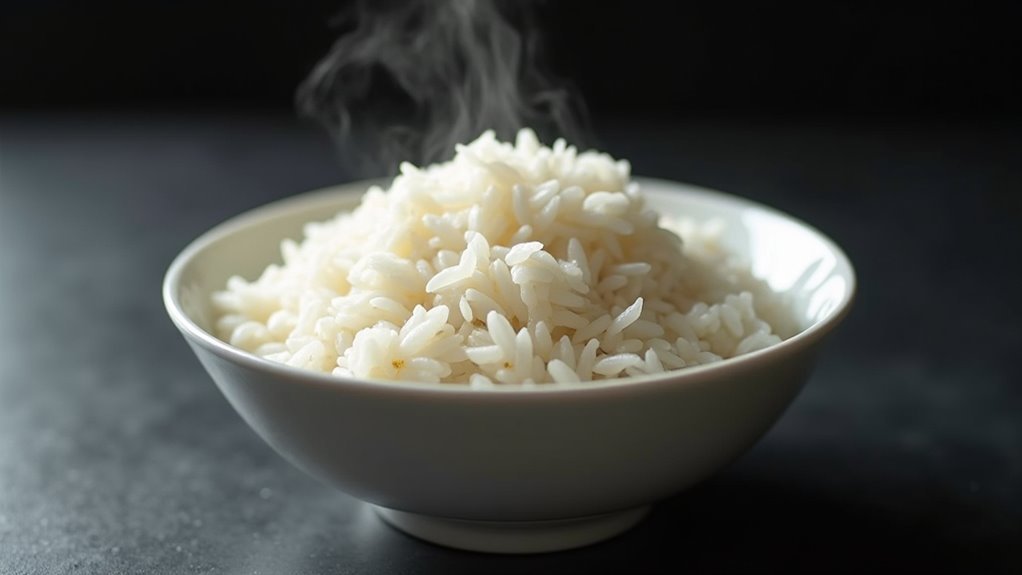
Getting the water-to-rice ratio right is honestly like finding the sweet spot on your favorite guitar – it takes a bit of practice, but once you’ve got it, you’ll never want to go back to guessing. Different rice varieties need different amounts of measured water for perfect rice every time.
| Rice Type | Water Ratio | Notes |
|---|---|---|
| White rice | 2:1 | Standard rice cooker ratio |
| Brown rice | 2.5:1 | Needs extra water |
| Jasmine rice | 1.25-1.5:1 | Less water for fluffiness |
| Basmati rice | 2:1 | Adjust for texture preference |
We’ve found that measuring your amount of rice accurately prevents mushy disasters. Additionally, brown rice is a nutritious alternative to white rice, making it a great choice for those looking for health benefits of brown rice.
Essential Steps for Preparing Rice Before Cooking
Four simple steps can transform your rice from decent to absolutely perfect, and honestly, skipping any of them is like trying to drive with one tire flat – you’ll get there, but it won’t be pretty.
Here’s what we’re doing:
- Rinse dry rice under cold water 3-4 times to remove excess starch for fluffier texture
- Use the plastic measuring cup that comes with your cooker (it’s actually ¾ US cup)
- Fill water to the corresponding line based on rice amount for optimal cooking results
- Soak white rice 15-30 minutes; brown rice needs 30-45 minutes. Cooking rice also requires maintaining the correct water-to-rice ratio, which is essential for achieving the desired texture.
- Using too much water creates soggy, overcooked grains
- Not measuring accurately with a proper measuring cup
- Forgetting to rinse the rice, leaving excess starch
- Cooking without a lid, causing uneven results
- Excess steam can’t escape properly, leaving rice sticky
- Steam and moisture don’t equalize, affecting texture
- You won’t achieve that fluffy rice consistency we’re after
- Immediate fluffing causes clumping instead of separation
- Rinse the rice under cold water to remove excess starch
- Follow the manufacturer’s water-to-rice ratio guidelines
- Add water to the line marked for your cup of rice amount
- Let rice rest covered for 10 minutes after cooking
After your cooked rice finishes, steam for additional 10 minutes before opening.
Common Mistakes That Lead to Ruined Rice
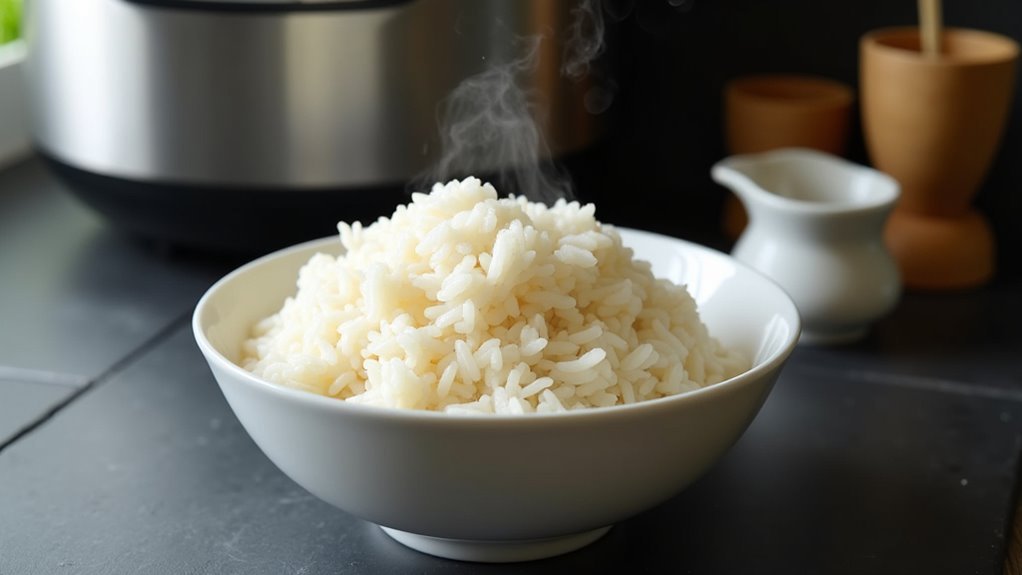
We’ve all been there—standing in the kitchen looking at a pot of what was supposed to be perfect rice but ended up as either a mushy mess or rock-hard grains that could probably chip a tooth. The truth is, even with a rice cooker doing most of the heavy lifting, there are still several ways we can mess things up without realizing it. Let’s talk about the three biggest culprits that’ll ruin your rice every time: getting the water-to-rice ratio wrong, skipping that essential rinse step, and—well, this one surprised me at first—not letting the rice rest after it’s done cooking. Properly rinsing rice before cooking can significantly improve the texture and prevent sticking.
Wrong Water-Rice Ratios
While it might seem straightforward, getting the water-to-rice ratio wrong is probably the fastest way to turn perfectly good rice into a disappointing mess. We’ve all been there – you think you’re being generous with water, but end up with mushy rice that’s basically inedible.
Here’s what typically goes wrong when we cook rice:
For white rice in your rice cooker, stick to that 2:1 ratio – it’s foolproof. If you find yourself with undercooked rice, remember to add water and steam for a few extra minutes to finish cooking.
Skipping Rice Rinse Step
Another mistake that’ll sabotage your rice before it even hits the cooker? Skipping the rinse process. We’re talking about removing excess starch that turns your fluffy rice dreams into mushy rice nightmares.
| With Rinsing | Without Rinsing |
|---|---|
| Fluffy, separate grains | Sticky, gummy texture |
| Proper water absorption | Thickened cooking water |
| No clumping when cool | Rice sticks together |
Rinsing rice three to four times under cold water removes dust and that troublesome starch. Without it, your water-to-rice ratio gets thrown off because the starch thickens everything up. The texture becomes—well, let’s just say nobody wants gluey rice. Parboiled rice, known for its higher nutrient retention, is particularly sensitive to rinsing, making this step even more crucial for achieving the desired texture.
Ignoring Rest Time
When you think your rice is done cooking, that’s actually—well, not quite the finish line yet. We’ve all been there, lifting that lid immediately because we’re excited to dig in. But ignoring proper resting time creates uneven moisture distribution throughout your rice.
Here’s what happens when you skip the rest:
Trust me, waiting 10-15 minutes allows better absorption and matches your texture preferences perfectly. Additionally, using the right amount of water in your rice cooker can significantly improve your cooking results and overall energy consumption.
Troubleshooting Sticky, Mushy, or Undercooked Rice
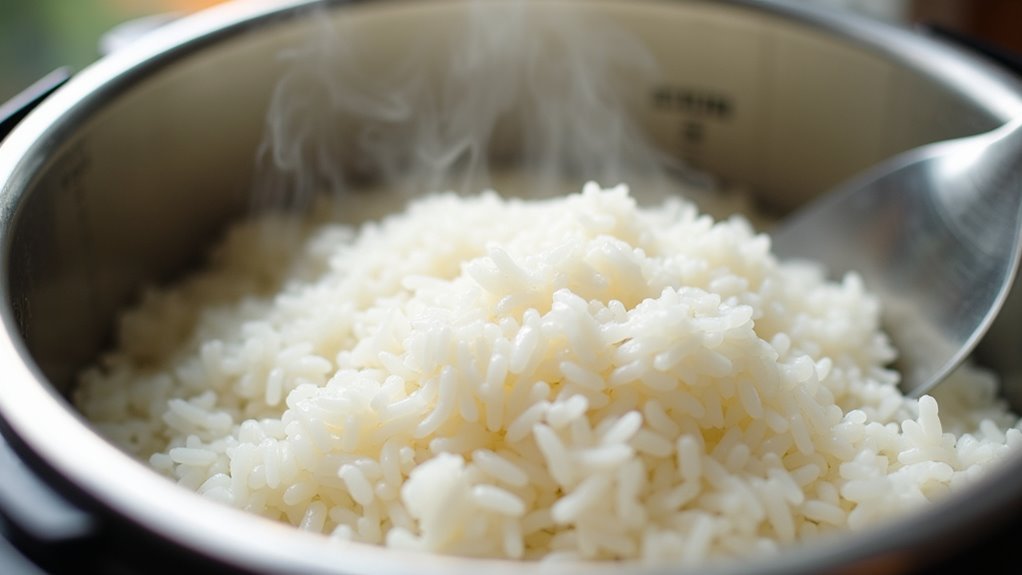
Even though rice cookers are designed to simplify cooking, we’ve all opened that lid to find disappointingly sticky, mushy, or crunchy rice staring back at us. The culprit? Usually it’s the water-to-rice ratio or skipping that essential rinse. When you don’t rinse rice properly, excess starch creates sticky rice that clumps together. For mushy rice, you’re probably using too much water—try 2:1 for white rice. Undercooked rice often means checking your cooker’s settings or cooking times. After cooking, fluffing rice with a spatula releases excess moisture. Always use a proper measuring cup for accuracy.
Pro Tips for Consistently Perfect Rice Every Time
Since we’ve covered what goes wrong, let’s talk about what actually works to get perfect rice every single time. Always use the plastic measuring cup that comes with your rice cooker—don’t substitute it. Trust me, it makes a difference.
Here’s what we always do for consistently perfect rice every time:
These steps will help you cook white rice perfectly.
Frequently Asked Questions
What Is the 5 5 5 Rule for Rice?
Like Goldilocks finding perfection, we use the 5-5-5 rule: five cups water per five cups rice. This rice cooking method guarantees proper water absorption across rice types, preventing common mistakes while achieving ideal rice texture.
What Is the Perfect Ratio for a Rice Cooker?
We’ve found the perfect ratio is 2:1 water-to-rice for white rice types. Different cooking methods require adjustments – brown rice needs 2.5:1. Avoid common mistakes like skipping rinses, which affects texture and flavor enhancers’ absorption.
How Much Water Do I Use for 2 Cups of Rice in a Rice Cooker?
Like a perfect dance partnership, we’ll use 4 cups of water for 2 cups of rice. This 2:1 water measurement guarantees ideal rice texture, proper cooking time, and steam efficiency while avoiding common mistakes.
What Is the Secret to Fluffy Rice?
We achieve fluffy rice texture through proper cooking techniques: rinse rice first, use correct water ratios, let it rest post-cooking, then gently fluff. These methods prevent common mistakes that ruin rice varieties.


